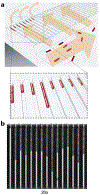Emerging Analytical Techniques for Rapid Pathogen Identification and Susceptibility Testing
- PMID: 30939033
- PMCID: PMC7369001
- DOI: 10.1146/annurev-anchem-061318-115529
Emerging Analytical Techniques for Rapid Pathogen Identification and Susceptibility Testing
Abstract
In the face of looming threats from multi-drug resistant microorganisms, there is a growing need for technologies that will enable rapid identification and drug susceptibility profiling of these pathogens in health care settings. In particular, recent progress in microfluidics and nucleic acid amplification is pushing the boundaries of timescale for diagnosing bacterial infections. With a diverse range of techniques and parallel developments in the field of analytical chemistry, an integrative perspective is needed to understand the significance of these developments. This review examines the scope of new developments in assay technologies grouped by key enabling domains of research. First, we examine recent development in nucleic acid amplification assays for rapid identification and drug susceptibility testing in bacterial infections. Next, we examine advances in microfluidics that facilitate acceleration of diagnostic assays via integration and scale. Lastly, recentdevelopments in biosensor technologies are reviewed. We conclude this review with perspectives on the use of emerging concepts to develop paradigm-changing assays.
Keywords: PCR; antibiotic susceptibility testing; high-resolution melting analysis; microfluidics; molecular diagnostics; point-of-care; polymerase chain reaction.
Conflict of interest statement
DISCLOSURE STATEMENT
The authors are not aware of any affiliations, memberships, funding, or financial holdings that might be perceived as affecting the objectivity of this review.
Figures






References
-
- Kumar A, Roberts D, Wood KE, Light B, Parrillo JE, et al. 2006. Duration of hypotension before initiation of effective antimicrobial therapy is the critical determinant of survival in human septic shock. Crit. Care Med 34:1589–96 - PubMed
-
- Jorgensen JH, Ferraro MJ. 2009. Antimicrobial susceptibility testing: a review of general principles and contemporary practices. Clin. Infect. Dis 49:1749–55 - PubMed
-
- Patel R 2015. MALDI-TOF MS for the diagnosis of infectious diseases. Clin. Chem 61:100–11 - PubMed
Publication types
MeSH terms
Substances
Grants and funding
LinkOut - more resources
Full Text Sources
Other Literature Sources
Medical

